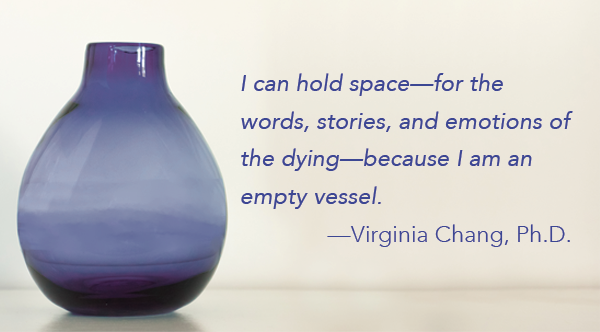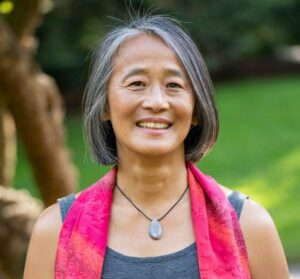Becoming an Empty Vessel
by Virginia Chang, Ph.D.

The Taoist Master Lu taught, “One can not follow what is with a full mind.” I have used this saying as a guiding principle in my work as an end-of-life doula. What does it teach me about showing up for others?
In my current, modern-day life, I am so busy with work, family, social activities, exercise/sports, and the daily grind—my life is so full. Then, on top of all the physical activities, there are the emotional stressors of anxiety, grief, uncertainty, and guilt, just to name a few—my mind is so full. It is not possible for me to see “what is.”
Master Lu’s teaching applies to not only how I may see myself—in a cluttered life—but also how I may see others. His saying has also been interpreted to mean that in order to connect to reality and react accordingly, one must first rid oneself of preconceived conventions and beliefs.
This means: How can I show up for others if my own being is so full? Not only must I rid myself of my own thoughts and worries, but also my preconceived conventions and beliefs of others. Then, I can truly listen and hear another. Then, it will be possible to see “what is.”
It is written in the Tao Te Ching:
“Thirty spokes share the wheel’s hub;
It is the center hole that makes it useful.
Shape clay into a vessel;
It is the space within that makes it useful.
Cut doors and windows for a room;
It is the holes that make it useful.
Therefore benefit comes from what is there;
Usefulness from what is not there.”
—Translation by Gia-fu Feng and Jane English
In writing these words, Lao Tzu is teaching that value comes from what is there, but the use from what is not. The wheel, the vessel, and the door have value, but it is what is not there that defines its usefulness. In the case of the wheel, it is the existence of the center hole which allows for the axle on which the wheel rotates. In the case of the vessel, it is the space which has potential. The emptiness of the vessel allows for its use to be defined, whether for containing or carrying. Therefore, an object “has no use without that which is absent.”
Imagine yourself as a clear and empty vessel. Nothing is in the way of seeing another and the situation clearly. Your mind is open, calm, and available. This state of mind originates from the Taoist concept of Wu, translated as “emptiness,” and is defined as “an inner realization or state of mind characterized by simplicity, quietude, patience, frugality, and restraint.” In this state of emptiness lies total openness, the ability to totally listen with no preconceived idea.
How can we relate this concept of Wu to end-of-life work? As an end-of-life doula, my role is to offer holistic and compassionate presence to the dying and their loved ones. As some of us have experienced, our presence can empower those in the dying process and positively impact the death. But Lao Tzu says that I am of no use if I am not first an empty vessel.
Emptiness invites stillness, clarity, and the unknown. While the unknown can feel scary and uncertain, it also provides space for wonder and learning. As doulas, can we enter every interaction with a client with that openness? Our trainings tell us that no two deaths are alike because people, illnesses, personal beliefs and values, environments, and circumstances always differ. The combination of all these factors makes each dying person and death unique, but only by being an empty vessel are we present to truly experience the uniqueness of each death.
Before every interaction with a client, I try to be an empty vessel. I have developed a ritual that rids myself of “me”—of my thoughts, worries, ideas, notions, and preconceptions. It is a combination of meditation, breathwork, and mindful movement. I do it before every meeting with a client, so I’m not bringing in “my shit” to the meeting.
Before I enter my client’s home, I can often be found in the shadows, two feet planted, eyes closed, quiet. I begin with some mindful movement—bringing awareness and intention to small, repetitive sequences of movement—based on my practice of yoga. My body welcomes the orchestrated yet familiar motion and begins to quiet, stilling the energy within. Then, I gradually introduce breathwork, coordinating my breath to my movements. This further quiets my body and begins to still my mind. When I sense the outside world on the periphery of my being—the sounds and smells there, but not engaged with—I begin to meditate. This last step further empties my being, resulting in an immense sense of calm, like a serene, ripple-less lake. This ritual takes only about 10 minutes to do, but makes all the difference in how I enter the space of the dying.
Now I am an empty vessel in the presence of the dying. I am truly open and listening to the individual in front of me. I can hold space—for the words, stories, and emotions of the dying—because I am an empty vessel. I hear the thoughts of the dying and reflect back our conversation.
“The still mind of the sage is the mirror of heaven and earth, the glass of all things.”
—The Writings of Chuang Tzu, Book 13 (translation by J. Legge)
I become an empty vessel to be of value and use for the dying. While we are together, my being “fills.” When we are done, my being is full. So, after meeting with a dying person, I need to become an empty vessel, again, for me. This is self-care; this is essential. I am no longer the vessel holding space for the dying person, and I must release the focus, intensity, and feelings of the client. I need to be me again. So, I perform another ritual at the end of every interaction with a client. It is similar to the one I do before entering, but this time I incorporate gratitude into the ritual:
“Thank you for the sharing, intimacy, and time we have spent together. Thank you for allowing me to be of service.”
The first time I become an empty vessel, I do it for the dying. The second time I become an empty vessel, I do it for myself.
When I open my eyes, I see the world around me anew. I let the sounds and sights fill me up again, and I open my being to refilling itself with me. A trick that works for me: I think about what I am going to eat. By homing in on a basic need, I become aware of my own wishes and desires. I feel the thoughts rush into my mind of my day and its schedule, planning, and execution. I take two steps and move on into the world.
So, consider how to empty your vessel. Whether it be meditation, movement, music, aromatherapy, or crystals, find what works for you. For when we are an empty vessel, then we can truly be present for another.
 Bio: Virginia Chang, Ph.D., is an INELDA-certified end-of-life doula and founder of Till The Last. She works as a doula privately and as a hospice and vigil volunteer for Visiting Nurse Service of New York (VNSNY). She is an instructor for the University of Vermont End-of-Life Doula Professional Certificate program as well as an established mentor in the field. She has written essays on death and the doula work which have appeared in Scientific American and has been featured in the media, including CNN, AARP, and MIT News. She sits on VNSNY’s Ethics Committee and Review Board and advises on matters of ethical significance to its hospice and palliative care program, and also works on racism and disparity issues in end-of-life care through the INELDA BIPOC Council. Virginia is passionate about increasing awareness of and sharing knowledge on end-of-life care, bioethics, and self-care.
Bio: Virginia Chang, Ph.D., is an INELDA-certified end-of-life doula and founder of Till The Last. She works as a doula privately and as a hospice and vigil volunteer for Visiting Nurse Service of New York (VNSNY). She is an instructor for the University of Vermont End-of-Life Doula Professional Certificate program as well as an established mentor in the field. She has written essays on death and the doula work which have appeared in Scientific American and has been featured in the media, including CNN, AARP, and MIT News. She sits on VNSNY’s Ethics Committee and Review Board and advises on matters of ethical significance to its hospice and palliative care program, and also works on racism and disparity issues in end-of-life care through the INELDA BIPOC Council. Virginia is passionate about increasing awareness of and sharing knowledge on end-of-life care, bioethics, and self-care.
